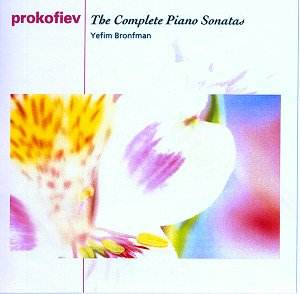Prokofiev’s nine mature Piano Sonatas (a fragment of
a tenth is the last music to have fallen from his pen and an eleventh
was in the planning stages at the time of his death) are a good analogy
for a journey through his musical life. From the strangely anachronistic
and lyrical harmonies of the First Sonata before the Revolution, through
the passionate expressiveness of the so-called "War Sonatas"
(Six, Seven and Eight) to the somewhat pallid Ninth at the end of his
life, the Piano Sonatas mirror Prokofiev’s musical development and inspiration.
Not that the First Piano Sonata was actually the first
work in this genre that the young Prokofiev had created – there are
at least six such sonatas among his ‘juvenilia’. However, it is the
first work about which the composer felt seriously enough to ascribe
an opus number to. Later in life he would refer to the work as forming
a watershed between his early period and his serious musicianship. Both
this and the Second Sonata show the influence of Myaskovsky, and there
is an unmistakable exploration of the ‘new music’ emanating from Scriabin
– an unavoidable influence on any Russian composer of the era. But in
the scherzo of the Second Sonata we can already hear the diabolical
technique and barely suppressed angst that will come to characterise
so much of Prokofiev’s music in the future.
It is not the purpose of this review to catalogue the
history of all nine of these works. But the fact they are a progression
is best heard when comparing the beginning of disc one (Sonatas One
and Two) with the end of disc two (Sonatas Six and Seven). The angularity
of the "War Sonatas" is so vastly different from the youthful
Romanticism of the earlier works that it is difficult to believe they
came from the same mind – until, that is, one knows something of the
musical influences, social pressures and personal insecurities at work
on this artist. Then, miraculously, the music falls into place and ‘makes
sense.’ Prokofiev is a classic example of a composer whose music becomes
much more appreciable once the listener can put the composer’s personality
in perspective – and other than his symphonies I can think of no other
cycle of his works that lends itself as easily to such an exercise.
Bronfman has a natural and well-known affinity for
Russian music, but his interpretations here progress beyond the merely
good to the almost revelatory. His performances of Six, Seven and Eight,
capturing the almost clinically cold nature of the discord while providing
a clear lyrical melodic line, are very possibly the best captured on
record. This is not to decry his performances of any of the other works
– but these three stand head and shoulders above the rest. The liner
notes tell us nothing about the dates of the recordings, but looking
at the original releases in the Sony catalogue reveals they were probably
made over a seven or eight year period. This may explain the identifiable
changes in style between some of the sonatas – or it may be Bronfman’s
conscious efforts to reflect Prokofiev’s developing musical personality.
Whichever the case may be, these are recordings that should be at the
top of every piano lover’s Want List – and Sony are to be congratulated
for releasing them under their "Essential Classics"
imprint.
Tim Mahon
Prokofiev Biography
